The Best Bed Bugs Pics in The World
Many people have heard the word “bed bug” at some time in their life, but not all of them really know what they look like. People are often unaware of the problem until they wake up with bites on their body, or when they find a small brown bug on their sheets. That’s when they get alarmed and start looking for information on social networks. For this reason, we have created this site, where you will find the best bed bugs pics so that you can correctly identify these insects and thus prevent a minor problem from becoming a real headache.
Bed Bugs Pics
Why is everyone so interested in bed bugs? This is because this pest has invaded many countries and reports of infestations have increased exponentially in recent years. If these bugs get into our house, we need to know what they look like and, more importantly, how to get rid of them.
What Are Bedbugs?
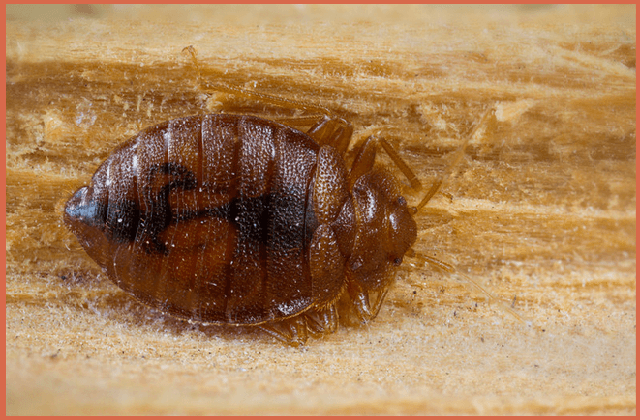
Bed bugs are reddish-brown insects about 5-7 mm or 3/16 – 1/4 inch long. The body is flat and oval-shaped if not fed recently. Its scientific name is Cimex Lectularius. They are nocturnal and their prefer food is blood. Unlike fleas that prefer to feed on our pets, bed bugs prefer to feed on human blood.
Bed Bug Anatomy
Like many other insects, bed bugs have six legs, a thorax, and an abdomen. On their heads they have a pair of antennae, each consisting of four knuckles. In addition to this, they have two large eyes and a proboscis that allows them to suck blood and inoculate substances into their victim.
Here you can see an image from National Geographic that shows the front of a bedbug. The proboscis can be clearly seen. You can also see the antennae and legs, which are covered with tiny hairs that serve as sensors.
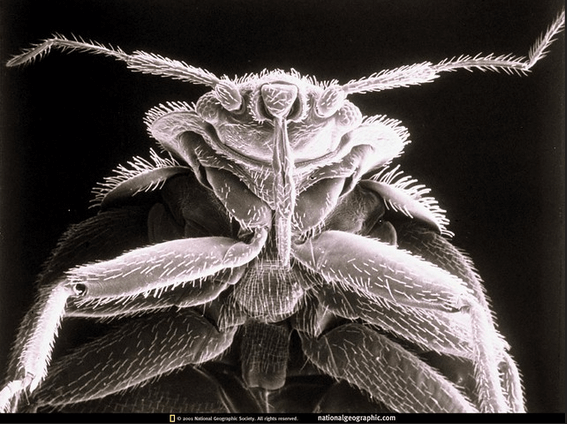
Bed bugs do not have wings and for this reason, they cannot fly. The body of the females is rounded, while that of the males is elongated. They are usually flat when not fed, but balloon-shaped when fed.
The female is larger than the male and in the fifth segment of her abdomen, there is a slit, which corresponds to a structure called the sperm, which is used for fertilization. In the case of males, on the abdomen, they have a small but robust nail-shaped extension, the organ used to fertilize the female.
This is another pic that shows a front view of a bed bug. It is possible to see the head with the antennae and even the eyes. The tiny hairs on the body can also be clearly seen.
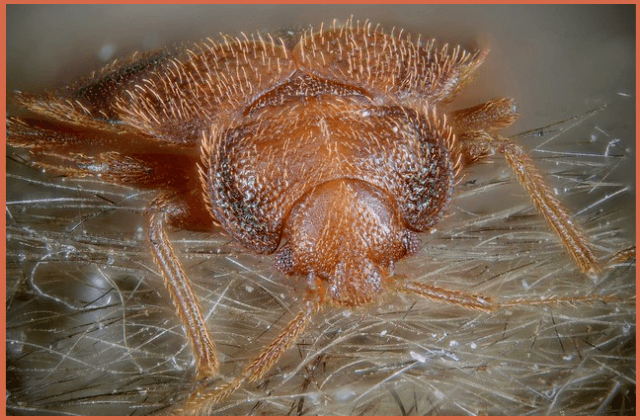
Several studies have established that bedbugs do not transmit any disease. However, they can cause other economic and public health problems.
Where Do Bed Bugs Come From?
Bed bugs can come from a variety of places, and they often make their way into your home unknowingly. They can hide in cracks and crevices easily thanks to their flat bodies. In addition, they are always looking for a place that offers darkness, isolation, and protection.
In the following photo from the University of Florida, we can see a bedbug that has just fed and is full of blood. When they feed they look like balloons.
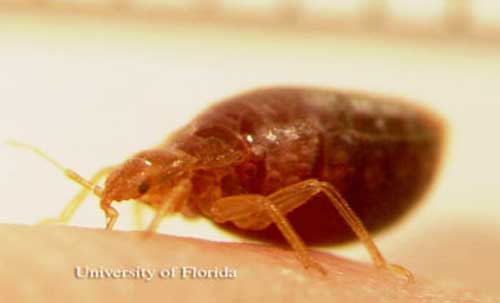
Bed bugs have two forms of dispersal, active and passive.
Active
This dispersal occurs when bed bugs walk short distances to reach their host. It also includes whether they are transported from room to room, or through ventilation ducts.
Passive
It’s what we humans do to clothes, luggage, furniture, etc. Therefore, the current movements of human populations could be contributing to their global dispersal. Other theories about the resurgence of this problem focus on the sale of second-hand furniture.
Where Bed Bugs Hide?
Bed bugs are nocturnal, hiding well during the day and emerging quickly at night to feed. They love darkness and isolation and are preferably hidden in the seams of mattresses or under the bed. They can also be hidden in the headboard, the box spring, and places near the bed.
The next picture shows a nest of bed bugs hidden in a mattress. It is possible to see adult forms next to immature forms. Bed bug droppings can also be seen.
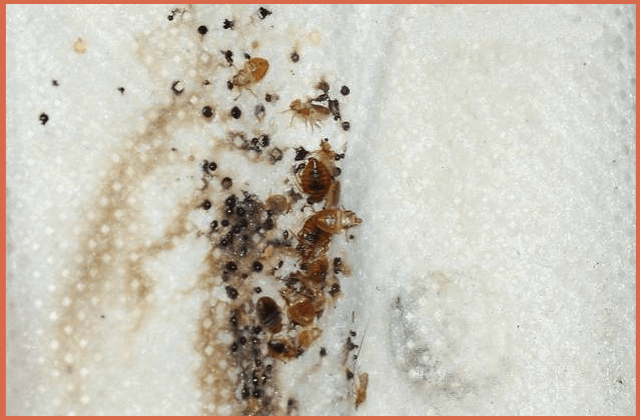
The sofa and furniture are also a perfect place to hide because it is the place where people rest and they will be an easy target for feeding. Clothing, in general, can be a focus and a den for bedbugs. Other possible hiding places are behind pictures, cabinets, nightstands, outlets, doors, windows, carpets, rugs, and any cracks. When infestations are very large, they can colonize even on the ceiling.
People tend to associate bed bugs with poor cleaning. However, this is not entirely true, since they can also occur in clean environments, but since bedbugs are intelligent, they hide very well during the day, thus avoiding being discovered by cleaning staff.
Lifecycle
The bed bug life cycle is a bit complex and begins with mating. However, with the help of these beautiful bed bugs pics, you will be able to know each of the phases without problems. Bed bugs reproduce through a process called traumatic insemination, a process in which the male pierces the shell of the female to deposit her semen.
The females only mate once and lay their eggs after 8 weeks. To do so, it must feed at least once. A female bed bug can lay 200 to 500 eggs in her lifetime, which is enough to create a new infestation. In the following image, we can see the different stages of the life cycle of bedbugs.

Eggs are oval in shape, only 1/16 inch long, and white and translucent. Once the eggs hatch, the nymphs are born, which must feed quickly, since at this stage they are very sensitive, if they do not they die within a few days. Nymphs must go through 5 stages before becoming adults. As they move from one stage to another, they shed their skin (or exoskeleton).
This is a picture showing what the eggs look like. Eggs that are hatched look misshapen.
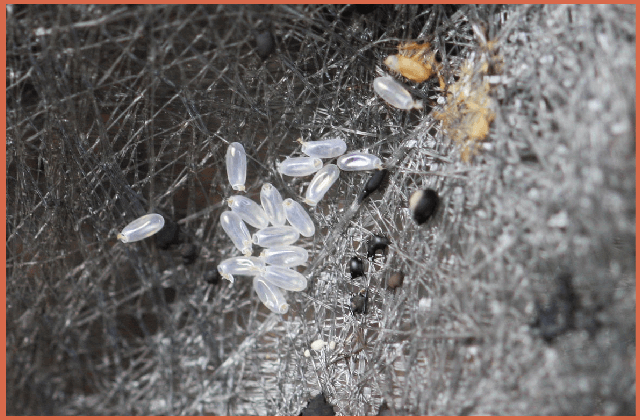
The nymphs are whitish-yellow. Adults are reddish-brown. The lifespan of these bugs generally ranges from four to six months.
Bed bugs prefer to live in colonies. In the colonies, it is possible to find adult forms, nymphs, and eggs, as well as droppings and shells of shed skins.
When the nymphs feed they change color due to the ingested blood.
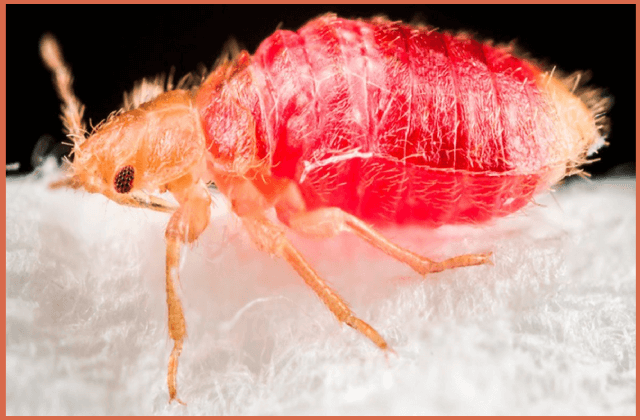
They can survive and remain active in temperatures as low as 46°F (7°C), but die when their body temperature reaches 113°F (45°C).
Bed Bug Bites
Bed bugs feed on blood. To do so, they bite the exposed skin of sleeping humans and animals. When bedbugs bite, they inoculate a powerful anesthetic. For this reason, people do not feel the bites until some time after they occur.
The most common symptoms that you have bed bugs at home are skin bites. Bed bug bites look like small red bumps on the skin that are quite itchy. These pits usually have a linear or zig-zag pattern. Itching symptoms appear 10 minutes to 2 hours after the bite. The itching usually occurs in the morning hours just after waking up.
The lesions are not painful and usually, nothing needs to be done to heal them. However, sometimes bites can become inflamed from excessive scratching and topical antihistamines are needed to relieve swelling. Therefore, avoid scratching the affected area too much to prevent a major skin infection.
In the following image, it is possible to see the bed bug bites on the back of a woman. The type of lesion is quite particular: bumps around 1 cm in size that scratch a lot.
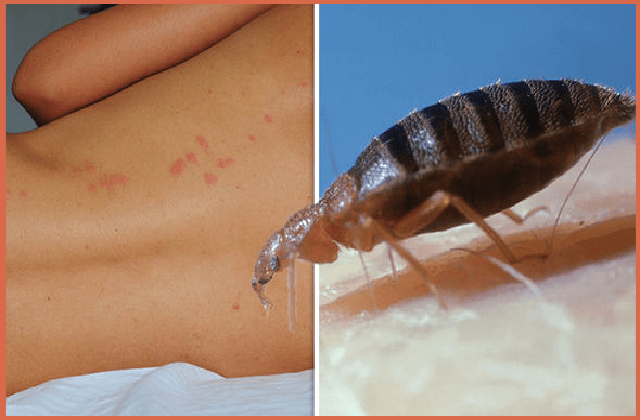
What Do Bed Bug Droppings Look Like?
Other signs that bed bugs are present are droppings and a bad smell. Once they feed, they leave trails of droppings wherever they walk. Usually, these spots are small dark brown almost black drops, due to digested blood. Stains can appear on sheets, mattresses, pillows, headboards, bed edges, and other walking surfaces.
Here we can see the dark stains of excrement on a wall. The spots are large, indicating that they are adult bed bugs that are feeding very well.

Identifying stains caused by bed bug droppings can indicate their presence, but it is not definitive proof. Seeing a real bed bug is the only way to be sure.
Treatments For Bites
It is not necessary to treat the bites as they heal on their own. If you have a lot of itchiness, you can use a cream with Hydrocortisone or Betamethasone and an oral antihistamine, such as diphenhydramine to reduce itching. You can also use calamine lotion or apply ice to the bites. In case of infection visit your GP.
How to eliminate Bedbugs
It is recommended to order and clean before carrying out any type of treatment.
You should vacuum all furniture and surfaces.
The most widely used treatment to eliminate bedbugs is “dry steam” at 50°C for one minute. This treatment is effective against all stages (eggs, nymphs, and adults).
Use a handheld sprayer for bugs, and especially eggs, on luggage, clothing, upholstered items, or wherever they are found.
Diatomaceous earth is widely used to kill bed bugs. It is a type of sedimentary rock that is used to kill bed bugs. This “sand” does not kill the insect by poisoning but by dehydration.

Some home remedies to get rid of bed bugs include Baking Soda, Borax, salt, vinegar, cloves, and cinnamon. Although its effectiveness has not been scientifically proven and in most cases, it aggravates the problem.
No measure is effective by itself, the different treatments must be combined and integrated to obtain optimal results.
If the infestation is very large, it is best to call a professional pest control service.
How to Avoid Bedbugs
- It is recommended to take special care when traveling and staying in a hotel. If you spend the night in a hotel you should spend five minutes inspecting the room. The first thing you should do is leave your bags in the bathroom.
- You should also be careful when visiting your neighbors or relatives. You should also be careful in places like apartment or condominium buildings, large office spaces, hotels, vacation rentals, cruise ships, and daycare centers, among others.
- If you suspect you have bed bugs in your home, you need to act fast. The chances of finding them are increased if you look for them at night with the lights off and with a flashlight. The first thing you should do is check your mattress. You should check the edges and seams very well. Then flip the mattress over and check underneath. Be sure to check the frames and borders of the bed; don’t forget to check the header.
- If you have furniture in your room, remove all cushions and carefully check all seams and crevices with a flashlight, just as you did on your bed. If you have a dresser or a piece of furniture with drawers, you should empty them and remove them to clean them.
- For homes with carpets, it is recommended to check the edges and seams. Remove all outlet covers and switch plates to check walls for bed bugs.
- Avoid clutter, as this makes it easier for bed bugs to hide and harder to get rid of.
- Avoid buying second-hand furniture, and when buying new furniture, choose furniture made from materials that don’t have crevices or seams.
- Fill cracks with cement or plaster.
Conclusion
Although bedbugs do not transmit any disease, they have become a problem of great importance in public health. Bedbugs generate stress, insomnia, low work performance, and other associated pathologies. Remember, the more we know our enemy, the more we can control it. With these simple bed bugs pics, you will be able to more easily identify these insects and thus keep them under control. This way you avoid expenses and major problems in the future.